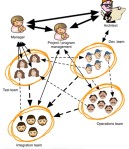
In today’s complex business landscape, cross-functional collaboration is vital for delivering valuable programs and products, whether in start-ups, small businesses, or large organizations. Technical Program Managers (TPgMs) play a crucial role in ensuring smooth operations within these collaborations. One of the key practices they employ is conducting Big Room planning or alignment sessions to execute strategic programs. In this blog, I’ll share some valuable recommendations to make these sessions more effective.
Clear Agenda: Begin by setting a clear agenda for the meeting. Surprisingly, 67% of meetings lack a well-defined agenda. Providing context through a meeting invite with a clear agenda is crucial. This enables attendees to come prepared, leading to a more productive discussion.
Timing Considerations: With teams spanning different time zones, it’s essential to choose a time that accommodates most key stakeholders. If finding a suitable time for everyone proves challenging, consider working individually with those unable to attend and find alternatives, such as sending delegates to represent them.
Single Threaded Leaders (STLs): Prior to the session, identify domain owners and communicate their roles and responsibilities. Designating Single Threaded Leaders for each function ensures clear accountability and presence of the right leaders for decision-making.
Do Your Homework: To avoid getting derailed during the meeting, it’s crucial to be well-prepared. Invest time in envisioning the discussion and collecting necessary data beforehand. Engage with relevant leaders to obtain high-level estimates or information required for the session.
Focus on the Outcome: Keep the meeting focused on outcomes rather than outputs. As a technical program manager, steer discussions towards the broader objectives. Should conversations veer towards minutiae, encourage participants to address those matters separately.
Summarize and Send Meeting Notes: To conclude the session, summarize key points and action items before ending the call. Taking notes during the meeting is crucial for this step. Afterward, send out comprehensive meeting notes to all participants. This fosters clarity on objectives and action items, allows for upward reporting, and promotes unified understanding among team members.
Conducting effective Big Room planning and alignment sessions requires careful planning, facilitation, and attention to detail. As a technical program manager, your role is to orchestrate these meetings to maximize collaboration and drive successful outcomes.
I hope these tips prove helpful for your future sessions and enable you to achieve greater efficiency and alignment within your cross-functional teams. Feel free to share your thoughts and experiences in the comments below. Happy planning!

